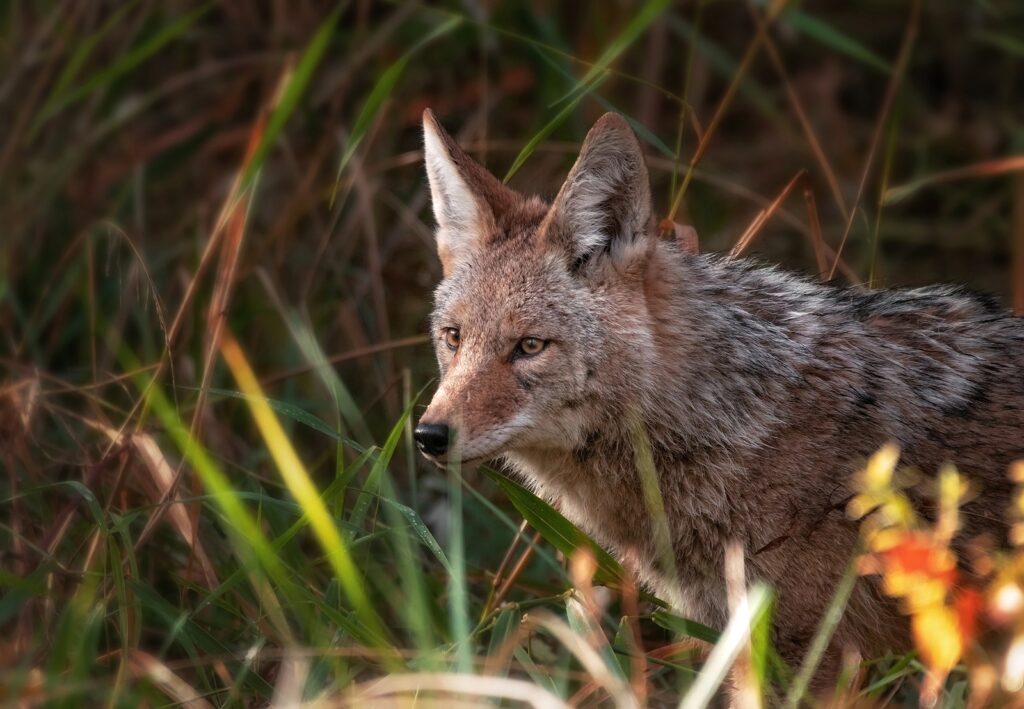Coyotes are very common throughout Central Indiana, in both rural and urban areas. Keep this in mind the next time you bend down to pet that wandering canine in your community. In cases like this, always be sure that the canine is not, in fact, a coyote. Although coyotes have a natural fear of humans, they are still primitive and predatory, which means they are capable of attacking you. Not only can a coyote attack serious injure or maim a person or pet, but it can also transmit a plethora of infectious diseases, such as Rabies.
If you live in an area where coyote sightings are common, it is wise to learn exactly what one looks like so that you can always tell the difference. Continue reading to learn a basic physical description of a coyote, and what you can do if they are a nuisance animal around your property.

Facts About Coyotes
As members of the Canidae family, both dogs and coyotes can easily resemble one another. Fortunately, the common coyote spotted here in Indiana have distinct features and behaviors that will allow you to easily tell the difference between them and domesticated dogs.
At first look, coyotes are covered in dense, thick fur, very similar to a dog’s coat, covering the neck and belly in full. The color of the fur coat is usually grayish-brown, but can vary between a light and dark gray, or warmer hues of brown.
In terms of size, coyotes tend to be slender and tall. Their fur makes them look much stockier than they really are. When fully grown, males can reach an average of 18 to 44 pounds, while females can grow to an average of 15 to 40 pounds.
Their faces are predator in style, with ears that point straight up and snouts that are slender and long. When they run or walk briskly, they carry their tails at the same level of their backs or lower. Dogs, and even gray wolves, carry their tails horizontally or vertically when running.
Coyotes are not necessarily nocturnal, but they are most active during sunset and sunrise, when people are usually not around. They are most populated in areas where there is an abundant source of food, water, and safe shelter. In countryside areas, they usually maintain an 8 to 12 square mile range. In urban areas they stay with a 2 to 5 mile range on average.
Breeding season in in late January, making March a time for newborn pups. Females generally give birth to more than one pup, usually between 4 and 7. They all stay in a den together until Fall, when pups emerge and care for themselves.
When coyotes are not scavenging on garbage and compost piles, they keep a carnivorous diet in nature. Their diet commonly consists of mice, voles, shrews, rabbits, hares, and squirrels. It may also include small amphibians, fish, insects, fruits, and seeds.
How to Get Rid of Coyotes in Indiana
If your property has a moderate to high level of coyote activity, it may be in your best interest to implement some safe and humane measures to protect your property and your loved ones, including your pets. Contact a local and trusted Indianapolis critter control company for prompt and professional coyote removal and control.
Do you have coyotes disturbing your property? Are they getting too close for comfort? Contact Budget Animal Removal at 317-875-3099 for professional coyote control in Indianapolis, Indiana. We provide residential and commercial services at the most competitive prices around.
Related Posts:
What to Do About Nuisance Coyotes in Indiana
Non-Toxic Repellent Recipe for Nuisance Wildlife
How to Protect Your Pets From Predator Birds
